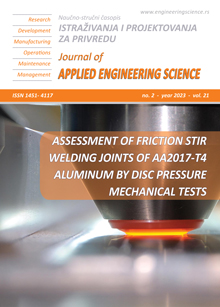THE EFFECT OF PITCH ANGLE VARIATION ON PERFORMANCE OF HYBRID DARRIEUS-SAVONIUS DUAL SHAFT VERTICAL WIND TURBINE
Abstract
All Vertical turbines use a fixed pitch angle; the determination of the pitch angle is very influential on the characteristics of a vertical wind turbine. In the initial stages of planning a Savonius Darrieus vertical turbine, an experiment was carried out to determine the best pitch angle, and the best pitch angle was 7 degrees. In its development, many designs have changed from the initial design, so it is necessary to carry out field experiments to get the best pitch angle. The purpose of this study is to recommend the best pitch angle for hybrid Savonius Darrieus dual shaft vertical wind turbines. That suit each wind characteristic with the variable performance tip speed ratio (TSR) also (λ), coefficient of performance (Cp), mechanical power and mechanical energy. Data is collected for 8 hours in real-time, using proximity sensors, anemometers, and an Arduino Mega to record and store data on a computer. The data collection interval at every 10 seconds. The data obtained is the RPM of the rotor and the RPM of the anemometer. The results of this study are the recommended pitch angle according to the wind speed, pitch angle of 5 degrees for 1 m/s wind speed, pitch angle of 8 degrees for 2 m/s a, and pitch angle of 8 degrees for 3 m/s wind speed.
References
Erwin, Wiyono S, Listijorini E, Lusiani R, Soemardi TP. Development of the Third Darrieus Blade of Sultan Wind Turbine for Low Wind Speed. Applied Mechanics and Materials. 2015;758:13-9.
Mohamed MH. Performance investigation of H-rotor Darrieus turbine with new airfoil shapes. Energy. 2012 2012/11/01/;47(1):522-30.
Martosaputro S, Murti N. Blowing the Wind Energy in Indonesia. Energy Procedia. 2014 2014/01/01/;47:273-82.
Alam MK. Effect of blade pitch angle on the performance of a wind turbine. Engineering e-Transaction (1823-6379). 2012;7:135-8.
Abdulkareem M, Hussain AA, Salman R. Study the Effect of Blade Angles on the Performance of Axial Six Blades Wind Turbine. International Journal of Engineering and Technology. 2019;7:945-9.
Chaichana T, Thongdee S. Effect of blade number and angle on the characteristics of the savonius type wind turbine. Journal of Physics: Conference Series. 2019 2019/11;1380:012110.
A.R S, Pandey MC, Sunil N, N.S S, Mugundhan V, Velamati RK. Numerical study of effect of pitch angle on performance characteristics of a HAWT. Engineering Science and Technology, an International Journal. 2016 2016/03/01/;19(1):632-41.
Erwin Erwin TPS, Adi Surjosatyo, Sakti Nurfuadi, Slamet Wiyono. Performance investigation of dual shaft hybrid vertical turbines using directional fins. Eastern-European Journal of Enterprise Technology. [Scientific Journal]. 2019;5(8):6.
Tjiu W, Marnoto T, Sohif M, Ruslan MH, Sopian K. Darrieus vertical axis wind turbine for power generation I: Assessment of Darrieus VAWT configurations. Renewable Energy. 2015;75:50–67.
Erwin E, Soemardi TP, Surjosatyo A, Nugroho YS, Nugraha K, Andayani RD, et al. Analysis of near wake recovery scale model vawt hybrid wind turbin in wind tunnel. IOP Conference Series: Materials Science and Engineering. 2019 2019/05/03;508:012068.
IEC. Wind turbines – Part 12-1: Power performance measurements of electricity producing wind turbines International Electrotechnical Commission 2020.

